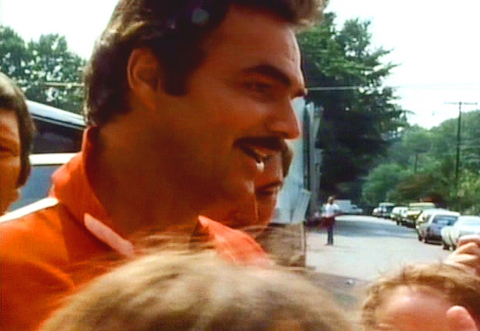Taipei's loss is Taichung's gain.
With much fanfare, the Taiwan International Documentary Festival (TIDF) has bid farewell to the nation's capital, home to the biennial event for the last decade, and moved south to Taichung under the auspices of the National Taiwan Museum of Fine Arts.
This year's format was patterned after a similar festival held by New York City's Museum of Fine Arts (MoMA), festival director Jane Yu (游惠貞) said.

PHOTOS COURTESY OF TIDF
“New York's MoMA has built up an extensive film archive since 1935 and staged Documentary Fortnight [an annual showcase for non-fiction cinema] since 2000. So we think it was only proper to choose the most reputed museum as our model,” said Yu, a veteran programmer who is TIDF curator for the third time.
MoMA has organized one of this year's programs, American Documentary 1920s — Now. It features 12 films chosen as representative of breakthroughs in cinematic form and vocabulary over the history of documentary filmmaking. Sally Berger, the assistant curator of MoMA's Department of Film and Media, will share her institution's experiences with local professionals and museum administrators in a lecture.
To further integrate film into the museum space, a program titled Horizon will screen five interdisciplinary shorts in the museum's spacious exhibition room, much like video art pieces are presented in a fine arts gallery.

Another peculiar feature of this year's festival is its director in focus, Artur Zmijewski. A radical who defies documentary cinema's ethics in realizing his extreme concepts, the Polish filmmaker has created a series of constructed works on bodily dysfunctions and the physicality of human beings in relation to their intellectual and spiritual dimensions.
Whether it is quadriplegics making failed attempts to walk with the assistance of able-bodied men in Out For a Walk or a choir of severely hearing-impaired children singing Bach's Cantata 147 in Singing Lesson 2, Zmijewski's works force audiences to take a close but uncomfortable look at the subjects' bodies and accept the otherness of their worlds in order to challenge social constructs of what it means to be human.
The winner of the Golden Lion Award at this year's Venice International Film Festival for his latest feature Still Life (三峽好人), Chinese director Jia Zhangke (賈樟柯) will pay his first visit to Taiwan to screen his documentary Dong (東), which follows painter Liu Xiaodong's (劉小東) journey through the Three Gorges and Bangkok. Meanwhile, five Taiwanese directors will compete with each other in the international competition section, with works covering diverse forms and content ranging from betel nut beauties and corporal punishment to the lost history of Taiwanese child laborers who were sent to Japan to build fighter planes during World War II.

One of festival director Yu's favorites is the Up Series, by Hollywood director Michael Apted. The ongoing series was first produced by Britain's Granada Television network in 1964, when 14 children from different social backgrounds were chosen as subjects and revisited by the crew every seven years to shed light on the British class system.
Also aiming to become a platform for Asian documentary cinema, the festival turns to Southeast Asia this year for a line-up that includes inspiring works by four internationally acclaimed filmmakers from the region. Cambodia's Rithy Panh merges documentary with theater in The Actors of the Burned-out Theatre, in which he follows five Cambodian artists searching for a form of expression in a country whose traditional culture was severely damaged, and almost eradicated under Pol Pot's murderous regime. Malaysian director Amir Muhammad's The Last Communist is a semi-musical documentary that mixes interviews with “specially composed songs in the mould of old-fashioned propaganda films,” to tell the life story of Chin Peng, the exiled leader of the now-disbanded Malayan Communist Party. The film was banned in Malaysia earlier this year.
Mysterious Object at Noon is a hybrid documentary by Thai director Apichatpong Weerasethakul, in which amateur actors perform scenes from a story told by real people living in a small village outside Bangkok. And Shape of the Moon is Indonesian filmmaker Leonard Retel Helmrich's poetic look at unrest in the world's largest Muslim country over the last decade as seen through the eyes of three generations of one family.

In the March 9 edition of the Taipei Times a piece by Ninon Godefroy ran with the headine “The quiet, gentle rhythm of Taiwan.” It started with the line “Taiwan is a small, humble place. There is no Eiffel Tower, no pyramids — no singular attraction that draws the world’s attention.” I laughed out loud at that. This was out of no disrespect for the author or the piece, which made some interesting analogies and good points about how both Din Tai Fung’s and Taiwan Semiconductor Manufacturing Co’s (TSMC, 台積電) meticulous attention to detail and quality are not quite up to

April 21 to April 27 Hsieh Er’s (謝娥) political fortunes were rising fast after she got out of jail and joined the Chinese Nationalist Party (KMT) in December 1945. Not only did she hold key positions in various committees, she was elected the only woman on the Taipei City Council and headed to Nanjing in 1946 as the sole Taiwanese female representative to the National Constituent Assembly. With the support of first lady Soong May-ling (宋美齡), she started the Taipei Women’s Association and Taiwan Provincial Women’s Association, where she

Chinese Nationalist Party (KMT) Chairman Eric Chu (朱立倫) hatched a bold plan to charge forward and seize the initiative when he held a protest in front of the Taipei City Prosecutors’ Office. Though risky, because illegal, its success would help tackle at least six problems facing both himself and the KMT. What he did not see coming was Taipei Mayor Chiang Wan-an (將萬安) tripping him up out of the gate. In spite of Chu being the most consequential and successful KMT chairman since the early 2010s — arguably saving the party from financial ruin and restoring its electoral viability —

It is one of the more remarkable facts of Taiwan history that it was never occupied or claimed by any of the numerous kingdoms of southern China — Han or otherwise — that lay just across the water from it. None of their brilliant ministers ever discovered that Taiwan was a “core interest” of the state whose annexation was “inevitable.” As Paul Kua notes in an excellent monograph laying out how the Portuguese gave Taiwan the name “Formosa,” the first Europeans to express an interest in occupying Taiwan were the Spanish. Tonio Andrade in his seminal work, How Taiwan Became Chinese,